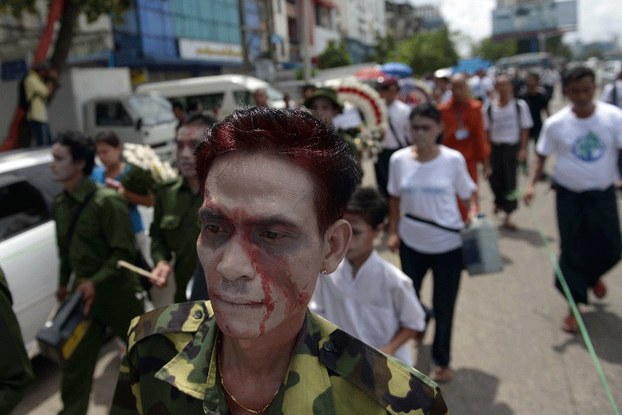




An International Red Cross delegation ended an assessment this week of hospitals and refugee camps in areas controlled by Myanmar's armed ethnic Kachin rebels amid reports of heavy fighting between rebels and government soldiers.
"We have been permitted to visit hospitals in Laiza and Majayang for a medical assessment which could lead to a medical program afterwards," Dominik Urban, the delegation leader of the International Committee of the Red Cross (ICRC), told RFA Myanmar's Service after a four-day visit to the rebel strongholds.
The visit from Aug. 29 to Sept. 2 also covered schools and hospitals in the Lagyayan refugee camps in Laiza, the headquarters of the Kachin Independence Army (KIA) fighting for greater autonomy in northern Kachin state near Myanmar's border with China, officials said.
The ICRC, which was allowed to resume prison visits in Myanmar by reformist President Thein Sein earlier this year, had said in a statement recently that it is exploring ways to enhance health-care delivery in conflict-affected Kachin and Shan states, where tens of thousands of civilians have reportedly been displaced.
In February, the ICRC conducted an initial visit to Kachin state, where it delivered essential medical equipment to three hospitals in rebel- and government-held areas.
"We are exploring ways to support both emergency and basic medical services in the area and to improve health infrastructure so that suitable services will be available to everyone who needs them. There is also a need to enhance physical rehabilitation services for landmine victims in the area," Alain Aeschlimann, the ICRC's head of operations for East and Southeast Asia and the Pacific said in a July statement.
Heavy fighting
The ICRC visit to the Kachin rebel headquarters came amid reports of heavy fighting, with one report saying that two government soldiers have been killed.
Clashes since June 2011 have forced nearly 200,000 people from over 300 villages in Kachin state to flee their homes, reports have said. Many are now stuck in government camps despite a tentative cease-fire.
"Two Burmese army lieutenants were killed and several injured in a rare bout of fighting with the KIA last week," a report by the Kachin News Group said, quoting local sources.
The two officers were killed in a conflict that began on Aug. 28 in an area between the Mali Hka river and Chyai Hka river in Machyangbaw Township, said the sources, who are members of a local church.
According to KIA officials in Laiza, the clashes began after Myanmar government troops and members of a local militia twice attacked a KIA post, the report said, adding that an unknown number of villagers in the battle zone had fled to surrounding areas for their safety.
Government attacks
Sumlut Gam, leader of the delegation of KIA's political wing the Kachin Independence Organization involved in peace talks with Thein Sein's administration, criticized what he called continuous government attacks on KIA bases.
"The KIO is keeping its troops under control in accordance with the Myitkyina seven-point agreement reached in May, whereas the government forces breached the agreement by attacking KIA bases," he said.
Last week, U.N. special envoy to Myanmar Vijay Nambiar also visited the KIA rebel headquarters in Laiza, meeting with officials from the group’s political wing and touring camps for people who remain displaced by fighting which ended under a peace agreement signed in May.
The Laiza visit followed the establishment of a KIO Technical Advisory Team in the government-controlled Kachin state capital Myitkyina last month as part of the seven-point peace agreement the two sides had signed.
Provisions in the agreement fell short of negotiating a full cease-fire but include monitoring mechanisms that have contributed to a reduction in military conflict in the region.
Reported by Kyaw Myo Min for RFA's Myanmar Service. Translated by Khet Mar. Written in English by Parameswaran Ponnudurai.